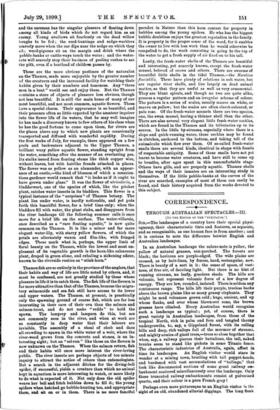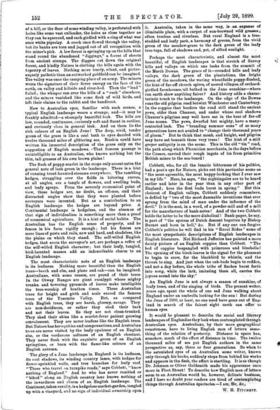CORRESPONDENCE.
THROUGH AUSTRALIAN SPECTACLES.—III.
[TO THE EDITOR OF THE "SPECTATOR.']
SIR,—The landscapes of a country have their special physi- ognomy, their characteristic tints and features, as separate, and as recognisable, as one human face is from another ; and it is curious to note the difference betwixt English and Australian landscapes.
In an Australian landscape the colour-note is yellow, the yellow of natural grasses, sun-parched. The forests are black; the horizons are purple-edged. The wide plains are crossed, as by hair-lines, by fences, hard, rectangular, new. There is beauty of a sort in it : the sense of space, of vast- ness, of free air, of dazzling light. But there is no hint of running streams, no leafy, gracious shade. The hills are volcanic, but represent volcanic force of a low degree of energy. They are low, rounded, isolated. There is seldom any continuous range. The hills lift their purple, treeless backs above the brown plains like so many grassy elephants. They might be mud volcanoes grown cold ; huge, ancient, and up whose flanks, and over whose blown-out cone, the brown grasses have climbed. Every Australian would recognise such a landscape as typical ; yet, of course, there is great variety in Australian landscapes, from those of the tropical North, rich in palm and fern and tangled thorny undergrowths, to, say, a Gippsland forest, with its rolling hills and deep, rich valleys full of the murmur of streams, and mighty armies of giant trees,—trees so close together that when, say, a railway pierces their battalions, the tall, naked trunks seem to stand like pickets in some Titanic fence. The characteristic industries of Australia, again, affect in time its landscapes. An English visitor would stare in wonder at a mining town, bristling with tall poppet-heads, and burdened with vast accumulations of "tailings," that look like disconnected sections of some great railway em- bankment scattered miscellaneously over the landscape. Ouiy these truncated railway embankments consist of pulverised quartz, and their colour is a pure French grey !
Perhaps even more picturesque to an English visitor ;If the sight of an old, abandoned alluvial diggings. The long flank-
of a hill, or the floor of some winding valley, is perforated with holes like some vast cullender, the holes as close together as they can be squeezed, and each girdled with a ring of what was once white pipeclay. A creek once flowed through the valley, but its banks are torn and jagged out of all recognition with the miner's pick. A low forest is springing up on the bills that stand round the abandoned " diggings," a forest of shoots from ancient stumps. The diggers cut down the original forest, and kindly Nature is clothing the hills again with the tapestry of leaves. Nothing more lonely, silent, and pictur. esquely pathetic than an outworked goldfield can be imagined. The valley was once the camping place of an army. The miners wrote the signature of their fierce energy on the face of the earth, on valley and hillside and river-bed. Then the " lead " failed ; the whisper ran over the hills of a " rash " elsewhere, and the miners vanished like some flock of wild birds, and left their claims to the rabbit and the bandicoot.
Now to Australian eyes, familiar with such scenes, a typical English landscape wears a strange, and—it may be frankly admitted—a strangely beautiful look. The hills are low, rounded, continuous, curiously soft and fluent in outline,
and curiously clean in general look. And on them lie the rich colours of an English June ! The deep, vivid, tender green of the grass is like a cool bath to eyes dazzled with twelve thousand miles of glittering sea. Raskin could have
written his immortal description of the grass only on the suggestion of English meadows. • That famous passage is unintelligible to an Australian, who knows nothing but the thin, tall grasses of his own brown plains !
The flush of poppy-scarlet in the crops only accent eatee the general note of lush green in the landscape. There is a hint of running trout-haunted streams everywhere. The rambling hedges, straggling over the fields in loitering curves, at all angles, are a tangle of flowers, and swelling buds, and leafy sprays. From the severely economical point of view, these hedges are, no doubt, an offence, and their distracted angles show that they were planted before surveyors were invented. But as a contribution to an English landscape the hedges are beyond price. A Continental landscape is hedgeless, and the absence of that sign of individualism is something more than a proof of economical agriculture. It is a hint of social habits. The Australian has the English sense of property, and he fences in his farm rigidly enough ; but his fences are mere lines of posts and rails, new and hard, and shadeless, like the plains on which they stand. The self-willed English hedges, that scorn the surveyor's art, are perhaps a reflex of the self-willed English character; but their leafy, tangled, bird-haunted masses add an indescribable charm to an English landscape.
The most characteristic note of an English landscape is its leafiness. Nothing more beautiful than the English trees—beech and elm, and plane and oak—can be imagined. Australians, with some reason, are proud of their trees. In the Otway Ranges are giant eucalypti whose mighty trunks, and towering pyramids of leaves make intelligible the tree-worship of heathen times. These Australian trees for height and girth and scale exceed the famous trees of the Yosemite Valley. Bat, as compared with English trees, they are harsh, gloomy, savage. They are non-deciduous, or rather they shed their bark and not their leaves. So they are not clean-trunked. They shed their skins like a scarlet-fever patient growing convalescent. They are never leafless like the English trees. But Nature has her equities and compensations, and Australian trees are never visited by the leafy opulence of an English elm, or the verdurous softness of an English chestnut. They never flash with the exquisite green of an English springtime, or burn with the flame-like colours of an English autumn.
• The glory of a June landscape in England is its leafiness, its cool shadows, its winding country lanes, with hedges for flower-sprinkled walls, and tree branches for leafy roof. "Those who travel on turnpike roads," says Cobbett, "know nothing of England." And he who has never rambled or " biked " along an English country lane knows nothing of the inwardness and charm of an English landscape. The Continent, taken rurally, is a hedgeless market-garden, tangled up with a vineyard, and no sign of individual ownership upon it. Australia, taken in the same way, is - expanse of illimitable plain, with a carpet of sun-browned wild• grasses ; often treeless and riverless. Bnt rural England is a tree- studded and leafy park, a harmony of greens, from the vivid green of the meadow-grass to the dark green of the leafy tree-tops, full of shadows and, yet, of sifted sunlight. .
Perhaps the most characteristic, and almost the most beautiful, of English landscapes is that stretch of Surrey hills and valleys on which one looks from the summit of the North Downs. The grace of it—rounded hills and leafy valleys, the dark green of the plantations, the bright green of the meadows, the waving wheatfields poppy-flusbed, the hint of far-off church spires, of nested villages, of orchard- girdled farmhouses,-all bathed in the June sunshine—where can earth show anything fairer? And history adds a charac- teristic touch to the landscape. On the edge of the Downs runs the old pilgrim road betwixt Winchester and Canterbury. In the coppice that borders the road still stand the ancient yew; older than Chaucer, and under whose cool shadows Chanter's pilgrims may well have sat in the heat of far-off
June noons. The yews, dwarfed but mighty, have a many- centuried look. The " branding summer suns " of so many generations have not availed to "change their thousand years of gloom." But to think that monk, and knight, and pilgrim
may have sat beneath these very trees ! The hint of a still greyer antiquity is on the scene. This is the old " tin " road, the path along which Phoenician merchants, in the days before the Cnsars, carried their rough ingots of tin from primitive British mines to the sea-board !
Cobbett, who, for all the lunatic bitterness of his politics, had a poet's eye for Nature, picks out this particular scene as "the most agreeable, the most happy-looking that I ever saw in my life." Here, he says, " the nightingales are to be heard earlier and later in the year than in any other part of England ; here the first bads burst in spring." But this choicest of English valleys, Cobbett suddenly remembers, is defiled by " two of the most damnable inventions that ever sprang from the mind of man under the influence of the devil." It is the seat, in a word, of a powder-mill and of a mill for the manufacture of bank-notes And of the two Cobbett holds the latter to be the more diabolical ! Bank-paper, he say, is part of " the system of Dutch descent begotten by Bishop Burnet and born in bell," &c. But if any one can forgive Cobbett's politics he will find in his " Rural Rides" some of the most sympathetic descriptions of English landscapes in English literature. Not Richard Jefferies has painted a more dainty picture of an English coppice than Cobbett. " The bed of coppice bespangled with primroses and bluebells I The opening of the birch-leaves is the signal for the pheasant to begin to crow, for the blackbird to whistle, and the thrush to sing. And just when the oak-buds begin to redden, and not a day before, the whole tribe of finches burst forth into song, while the lark, imitating them all, carries the joyous sound into the sky."
An English June is not always a season of sunshine, of leafy trees, and of the singing of birds. The present writer, years ago, spent the whole of one sad June walking about England under an umbrella looking for the sun ! But during the June of 1899, at least, no one need have gone out of Eng- land in search of the fairest sight earth can offer' to human eyes.
It would be pleasant to describe the social and literary landscapes of England as they look when contemplated through Australian eyes. Australians, by their mere geographical remoteness, have to living English men of letters some- thing of the relation of posterity. Distance in space has, somehow, much of the effect of distance in time. The twelve thousand miles of sea put English authors in the same perspective as, say, three or four generations. So when to the astonished eyes of an Australian some writer, known only through his books, suddenly steps from behind his works and appears in the flesh, the effect is startling. It is as though Dr. Johnson or Oliver Goldsmith made his appearance once more in Fleet Street! To describe how English men of letters seem to an Australian would be, however, delicate business, and I have no doubt your readers are tired of contemplating things through Australian epectacles.—I am, Sir, &c.,
W. H. }7ITCHETT.



































 Previous page
Previous page